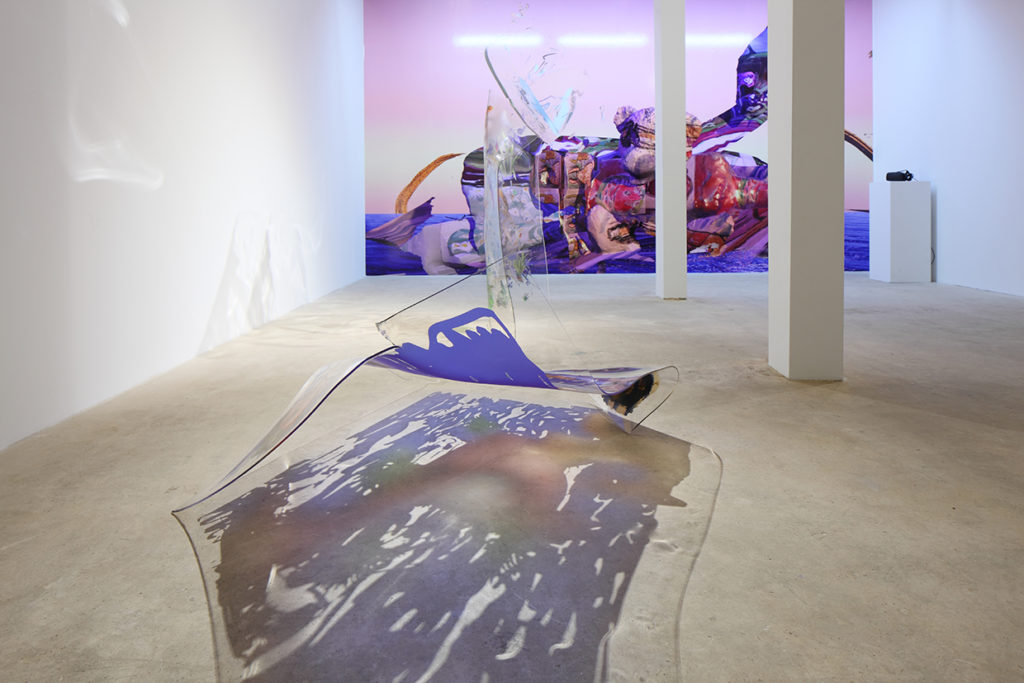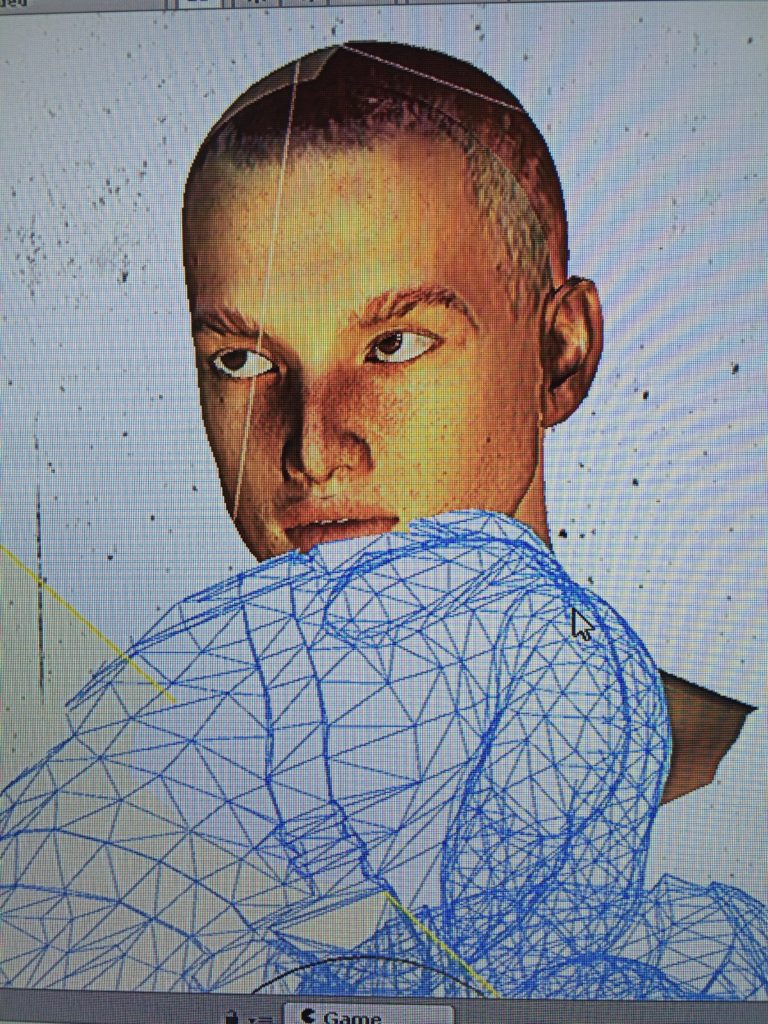Trace Inhabitant: Rachel Rossin in Conversation
by Caleb Mathern

Rachel Rossin is a New York-based artist whose exhibitions incorporate quite the media diaspora—from blowtorches and canaries, to deepfakes, holograms, virtual reality, and honest-to-God oil painting. Her practice is uniquely indescribable, in that it fixates so firmly on the experiential. An early adopter of VR (she received a prototype kit from Oculus Rift), an assembler of Tesla spirit radios, a programmer, and a painter, among other monikers, Rossin will end 2019 with shows reaching from an interactive projection at the Zabludowicz collection in London, to a newly commissioned headset piece for the Akron Museum of Art in Ohio.
The artist’s name resembles that of Rachael Rosen, the character from Philip K. Dick’s novel Do Androids Dream of Electric Sheep (1968) portrayed by Sean Young in Blade Runner. But the Sci-fi IP Rossin most resembles is Neo from the Matrix (1999-2003) sequels, who could fudge the lines between dual realities. In the following conversation, the artist sheds light on what goes on behind the scenes and screens, putting a bit of distance behind the spooky actions in her practice.
Caleb Mathern: You were not initially convinced you could affect the residual ghosting artifacts of a zoetrope phenomenon on a gallery-sized scale to complement the six-channel video show Stalking the Trace, at the Zabludowicz Collection earlier this year. But it worked. How?
Rachel Rossin: Have you ever looked at a video of a zoetrope? You know how when it is slowing down, it starts to look like there is an afterimage? In the installation, one would pass it like, “Whoa, what did I just see?” That is it. It is just a ghost for a second. It works like an optical illusion, similar to moiré patterns. The viewer keeps walking, expecting to see the next frame, but it will never be there.
When I was mocking up Stalking the Trace in VR, I kept getting this effect. I did not expect it to happen in real life, but it did—while I was on site, I tried to see if I could amplify the effect with a lighting sequence when viewers move through the room past the apertures . I am rarely surprised by my own work, but this piece was really fun. It would start to feel like people were floating, a sort of repeating déjà vu experience.
It really is simpler than it sounds. The gimmick within the work reveals something true about how simple we are. I mean, that is ultimately what a gimmick is—one can say, “Oh that is so cool,” but also, “Oh, the way I see reality is so frail and simple.” A lot of the delight I have with questions surrounding AI involves that.
CM: In your video for Phillips x DAATA, entitled Recursive Truth (2019), is it true that you worked with neural networks that are heavily utilized in deep surveillance artificial intelligence? This repurposing of questionable tech appears to surface across your works; for example, how you use raycasting as a navigational tool in your VR piece I Came and Went as a Ghost Hand (2015), which informs bullet physics in video games. Do these grander applications linger in your practice?
RR: The libraries and programs I am attracted to are symbolic. With surveillance libraries, which are what was used in Recursive Truth, I was trying to find new ways to express a reoccurring theme that I cannot seem to escape: uncanniness. On a programming level, I see libraries almost like AbEx painters looked to oil painting as material symbolism.

I am mainly using programming libraries that are ubiquitous—the first is called OPENCV; the bulk of our deep learning surveillance, image mapping, image tracking, and all facial recognition apps are built on this library. It is built into all of our phones. It is a meta-infrastructure. That is one reason why I chose to use it. It is really beautiful, but there is a materiality to it that is expressing something insidious.
The other is called a GAN (Generative Adversarial Network), a type of neural network used for AI that is more advanced, and mainly used at the moment for counterfeiting images—this is how I put my face on Steve Jobs’ and Marco Rubio’s bodies. It has what is called a ‘discriminator.’ With deepfakes and deep voice—these really advanced technological counterfeits—humans cannot tell the difference, since the computer basically treats itself as a human when judging it. There is a little node off to the end result that asks, “If I was a human would this pass?” for, say, George Bush talking.
Raycasting is used for many things, but the main application is for bullets in games. It is basically talking about trajectory points. On the VR headset, there is a raycast out from wherever your attention points to. In Ghost Hand it is slowly prioritizing an entropy script. It is actually eating parts of the image away depending on what you are looking at. That is what I am attracted to. Perhaps because I grew up playing First Person Shooter games, I make a lot of interventions—I am troubled by much of the simulacrum of violence. I like using and exploiting that.
I find that the materialism of things that feel ephemeral or invisible is what drives a lot of my work. There is something nice about whitewashing the ethics of what most of this code is used for. I pick programming languages and libraries that have a specific type of materialism and salience to where digital technology places us.
CM: What does uncanny (not just in reference to the uncanny valley) mean to you and your practice? How does this relate to the Proteus effect, the phenomenon where people’s behavior shifts in accordance with their digital representation, and your commissioned piece examining the effect? Your view appears to reorient the term back to its Freudian connotation; of an incomplete familiar feeling rather than a visual metric for believability.
RR: Masahiro Mori coined that. The idea of the uncanny valley is the fall-off that happens through human representation in media, but ‘uncanny’ was first spoken about by [Ernst] Jentsch. Freud popularized “the uncanny,” defining it as locating the unfamiliar in the familiar—the sense of being displaced, or not feeling there is a home. Jacques Lacan later expanded on that; the evolution of where the eerie meets the familiar. I felt this once before. I had seen the Hudson River Valley in paintings before I had seen the Hudson River Valley.
The Proteus effect is more personal, psychological—it is the way we fill in the gaps when we see a representation of ourselves. I think this is really apt for how I experience reality, and how most people experience reality today. Whenever there is a digital representation of a person, especially in VR, your brain projects onto the avatar. You take on the characteristics of how you perceive you are embodied. These characteristics are integrated and then folded into your personality. I see this effect so often in these virtual spaces—so much of the research I was doing took place in VR Chat. I started to find the name for it; the way I would regard myself would change every time I changed an avatar’s body. It is all about body-hopping. There is an eeriness that is felt when you see a representation of yourself, when instead you are expect to see your own body. Most of my work is seated from the perspective of embodiment.
The commission for the Akron Art Museum is headsetbased, where viewers are moving in and out of these bodies that I present them. They shed avatars like skins or husks, and when the new avatar comes, it dislocates and explodes the previous, based on how fast the viewer is moving and where their arms are. I have a library of basically all the avatars that exist in the world. It is almost an infinite generative simulation. Raphael from the Teenage Mutant Ninja Turtles is in there.
CM: How does your practice evolve in the face of current forecasting in VR gaming? VR is experiencing a downturn because investors are turning to cybersecurity and AI. Think-pieces declaring VR Death are here, though they have been for years. If virtual reality is not the endgame for you, what is?
RR: It is always hard for me to make these types of speculative forecasts on technology. People are asking, “Where is VR going? Is it a thing?” The answer is, of course it is. It is just too goddamned practical—unless there is some mass shift in the way commerce and our culture runs. At this moment, we are running on a hyper-acceleration boom. We are in an attention-based economy. It gets scary because our productivity—Elon Musk talks about this too—is all in our thumbs. We are driving these entire systems with our thumbs. It is an insane concept, especially when one could be using their entire body to move things.
For my paintings I use a VR sketch-up program to mock them up. I treat them like plein air paintings, but instead by moving through digital landscapes. I am not using a screen and a mouse. VR is practical for education, for engineers, for medicine. It is really practical for therapy. The military alone will keep using it. I have a friend who has a whole school that is in VR. They can have these kids in a room with really cheap cell phones and really high quality classes. It is amazing. Honestly, we are probably moving more into biotechnology. That is the most practical because DNA data storage is really a hell-of-a-lot more reliable than digital storage.
I can build all of this stuff. I know the land really well, and I can subsist off of it. I can build my own equipment if it ceases to exist commercially. We are edging the bounds of something that is constantly shifting.
CM: Is it true that you taught canaries dubstep?
RR: Yes—it is a project I did for my first show, N=7 at Signal in 2015. This canary would burst out into dubstep. I was first inspired after reading about a study about songbirds’ waveforms being related to electronic noises.
I love dubstep. I think it is fantastic for a lot of reasons—the build-up and release is very appropriate for how we are feeling right now, and what is happening to us on a biological scale. There are many people who have talked about this in a better way than I will. The same thing happens to our brains when we listen to dubstep as say, an orgasm, like a release of an insane amount of tension. That is why people like a drop, which is really funny. I do not care about the orgasm part of it, but I do care that it is mimicking something that is natural.
You can be hypnotized through sound, by subconscious signifiers that are present in a lot of electronic music. The megahertz that is in EDM or trance music actually massages your brain into similar rhythms. Heartbeats, the lymphatic system, all have frequencies that are familiar to our brain, but are not perceived by us. These are all of the patterns that electronic music finds its natural groove in. Birds also have these patterns; they are built from the same meat as us. Their brains are very similar, the way they move through reality is the same.
The colloquial mythology around canaries is interesting. We once used canaries in the coal mines—horses for travel, dogs to hunt food—as extensions of our body. There were peripherals for the human experience that we evolved biologically. We now see peripherals in cell phones as extensions of our cognitive function and memory. Navigation used to be something that was completely human, inside of us, extended by using a bird or the stars to navigate.